
Download | License | Files | Warranty | Contact Info | Requirements | Installation | Introduction | RMT! | Options | Commonly Asked Questions | Glossary | Bugs | Credits | History

Version 1.0
Last Updated: 10/12/2002
©2002 Fantasyware, Inc.
by Phil Erwin
All Rights Reserved
Written in Borland C++ 5.02
To obtain the latest version of the Pokémon RMT! program, go to the Downloads section.
This program is provided as freeware "as-is". You are free to distribute this program via Internet, BBS, newsgroup, or any other channel provided that all the files to this program are included. None of the files, including the program, may not be altered, decompiled, or reverse-engineered. No one other than the author may collect any charges or fees for use of this program.
The following files make up the complete Pokémon RMT! program:
| Filename | Description |
|---|---|
| ABOUT.TXT | Program text file for displaying credit information |
| INSTONLN.TXT | The on-line instructions file |
| INSTRUCT.TXT | Instructions document in simple text format |
| INSTRUCTIONS.PDF | Instructions document in PDF (Adobe Acrobat) format |
| MOVES.BIN | Program data file |
| README.TXT | Additional helpful notes and instructions |
| RMT!.EXE | The Pokémon RMT! program |
| RMT!.ICO | Icon file for the shortcut file |
| SHSHWI.RMT | Sample team saved file |
Since this program is freeware, the only firm guarantee I will make is that it will surely take up space on your hard drive. Every effort has been made to ensure this is a simple, useful, and easy to use program. However, I will not be held liable for any damages incurred by using this program.
If you have any problems with the program or just feel like sending some appreciation my way, feel free to contact me.
The latest version of this software may be found at:
PokéFAQs: http://oocities.com/thelegendarydogs
E-mail: thelegendarydogs@yahoo.com
This program is a DOS-based application that can be executed on almost any PC platform. It does not require Windows, but it does require an Intel 386 or compatible CPU and a VGA-compatible video card. It is usable with all versions of MS DOS, Windows 3.11, 95, 98, 2000, NT, Me, and XP.
The Pokémon RMT! setup program, SETUP.EXE, comes wrapped in the zipfile RMT10.ZIP. (The reason for this is because Yahoo does not allow executable files on their Geocities web servers.)
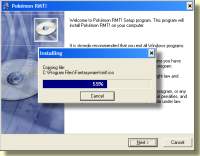 Installing
Pokémon RMT! is a snap. Unzip SETUP.EXE from RMT10.ZIP (using any unzip
utility such as Winzip) into a temporary
directory or the Windows Desktop. You may then either:
Installing
Pokémon RMT! is a snap. Unzip SETUP.EXE from RMT10.ZIP (using any unzip
utility such as Winzip) into a temporary
directory or the Windows Desktop. You may then either:
Setup will prompt you to choose a directory to install the Pokémon RMT! program into. In most circumstances, you will simply want to accept the default options. After clicking the Next button a few times, it will install all necessary files in their respective places, including placing a shortcut on your Windows Desktop. (You may delete the shortcut afterward if you wish.)
Note: Speaking for myself, I hate programs that inextricably fuse themselves into Windows and require a Masters degree in Computer Science to get them uninstalled. You may be at ease to know this setup program only installs a few files on your computer. It doesn't touch the registry or add anything to your Windows System folder. Removing the program is as easy as selecting Remove from the Add or Remove Programs applet. Make sure to use this option, though—don't just delete the files yourself or the program will remain registered as installed on your Programs list.
Special Note to pre-Windows users: If you are unable to run the SETUP.EXE file, it is also readable by any unzip utility. Create a directory on your hard drive and use your favorite unzip utility to place all the files there.
As time marches steadily forward, new legal moves for Pokémon are coming into existence from several sources (which is discussed in depth later). As these moves are identified, they will be updated for use within RMT!. The program file that controls legal moves, MOVES.BIN, will be available as a separate download. Check back at PokéFAQs from time to time and see if there is a more up-to-date moves file. (You can view the date and time of your MOVES.BIN file from the opening RMT! splash screen.)
When you first start playing Pokémon, whichever version that might be, you most likely play the game to completion. You may even choose to replay it several times, or move on to another version of Pokémon. Some people have found, after finishing the Pokémon games, that they wanting more. Many discover there is a lot of fun to be found going head-to-head with your favorite Pokémon against others. This may take the form of link-battles or online competitions (such as GSBot, NetBattle, PBS, etc.) It naturally leads, then, to trying to build and train the best team of Pokémon you can.
Traditionally, an intrepid Pokémon trainer spends quite a bit of time developing his or her team of mass destruction and then tests it in battle. If it doesn't live up to expectations, smart trainers ask knowledgeable Pokémon gurus to "Rate My Team!" Not surprisingly, these people are referred to as raters. They will hopefully offer productive feedback that will then let the trainer make appropriate changes to their lineup. This is exactly what the Pokémon RMT! program is designed to do!
There are many things to consider when developing your favorite winning team. Individual Pokémon have innate strengths and weaknesses, both in abilities and moves. Chansey has gobs of Health, but has horrible Attack and Defense. Smeargle has an incredible moveset potential, but has the abilities of Woody Allen without his glasses on. Onix has incredible Defense, yet it suffers from too many Type Weaknesses (x4 to Water and Grass, x2 to Ice, Fighting, Ground, and Steel!) Sometimes these details get complex and are not incredibly apparent until you get creamed by your opponent and your team lies decimated at your feet.
Pokémon RMT! has been designed to help you identify strengths and weaknesses in individual Pokémon and how well they contribute to your team overall. Once you enter your team, the program analyzes it and generates a list of possible problems. When it can, it also will offer suggestions for improvement.
Some of the things that RMT! assists you with include:
While RMT! is a wonderful tool for team development, it does not take the place of you, the Pokémon breeder/trainer/manager. You are ultimately responsible to use this tool wisely to help you make decisions about your team. This program may make suggestions that aren't right for you or your team. In that case, they should simply be disregarded. RMT! is not infallible, but it does help identify some aspects of your team that you may haven't considered.
Incidentally, the program itself is pretty cold and rational. It won't offer praise at a well thought out strategy or respect you for choosing a creative moveset. This is why you will also want to find human raters who will offer the personal touch.
 When
the program is started, the Main Menu will be displayed. The screen is split
into four windows:
When
the program is started, the Main Menu will be displayed. The screen is split
into four windows:
You may navigate the Main Menu by using the Up and Down-Arrow keys. Press Enter to select a particular option.
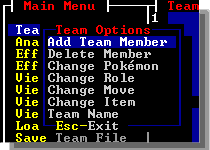 This
section handles the adding, changing, and deleting individual members of your
team. You may also decide and enter a name for your team.
This
section handles the adding, changing, and deleting individual members of your
team. You may also decide and enter a name for your team.
You may introduce a new Pokémon member into your team lineup here. You will be prompted to select which slot it will occupy, its type, moves, item, and its role in the team as a whole.
Select an empty slot for your Pokémon, from 1 to 6. If you have no empty slots, press Esc and use the Delete Member option.
Choose the Pokémon from the list of 251 different types. The list is sorted alphabetically to help you find what you're looking for quickly. Pressing the first letter of the desired Pokémon will jump you to the first Pokémon beginning with that letter.
If you don't know exactly which Pokémon you want, you may view all their strengths and weaknesses using the View Pokédex option.
You will have the option of entering up to four moves for your Pokémon. You will be prompted to select the Slot the move will be placed in and the move name.
Choose an empty move slot from 1 through 4.
Select a move from the Pokémon's moveset pool. The moves are sorted alphabetically.
|
Allowable moves may originate from several different sources:
The moves list has four different categories to account for these sources: R/B/Y, G/S/C, Breedable moves, and Pokémon Center moves. Stadium prizes and Move Tutor moves have been lumped into the G/S/C moves category.
A grayed-out move may not be selected. Such a move is not allowed based on the other moves currently selected in the moveset. RMT! ensures only legal movesets in the following way:
Choose an Item for your Pokémon to hold. Not every single item from the Pokémon G/S/C game may be held. Most of the items from the game are not appropriate for championship tournament play. Items that will not help when held in battle, like the Brick Piece or the S.S. Ticket, have been omitted.
Finally, you may select a role for your Pokémon. If you do not wish to assign a specific role, select None. You can change your Pokémon's role later if you wish.
Choose the slot of the Pokémon you want to remove from your team. This will free up a slot in your lineup for you to Add a Team Member.
Use this option if you want to change the Pokémon type of an existing team member. Select the slot of the Pokémon you want to change. Select the new Pokémon type from the list.
Note: If you select <none> from the list, it will effectively delete that Pokémon.
If the existing moveset is legal for the new Pokémon type chosen, it will allow you keep the moveset. If, however, the moveset is illegal, it will delete all its moves.
After choosing the Pokémon you want to change, select the new Role from the list. Any role can be chosen; if the Pokémon does not have the requisites for that role, this will be identified in the Analysis.
This section, as well as others, makes reference to Grades. Grading is a very important aspect to the internal workings of RMT! and are used very much ones you get in school. A Grade of A+ is the best, F- is the worse, and C is average. Some roles require a certain grade or grades in key areas to qualify for that role.
Currently, the list of possible roles is:
 Tank
TankSelect the Pokémon and move slot you wish to change. Choose the new move from the list of possible moves. If you press ESC, no changes will be made.
Choose the Pokémon whose item you want to change. Select from the list of possible useful items. Pressing ESC aborts the operation.
You may enter or change the name of your team. It may be up to 20 characters and may be anything you wish. Use your imagination to invent a descriptive name, such as Shshwi's Pride, The Monster Squad, Bobby's Bashers, whatever you like.
If you change your mind and don't want to change the name, press ESC.
This section is the heart of the program, the most useful and important to the team manager. Here is where you get the feedback on your team as it currently stands. You can and should use this option frequently to determine opportunities for improvement in your team.
 An
analysis is prepared and displayed in the Analysis window. It will consist of
various issues that RMT! sees as potential problems. Pressing Ctrl+Up-Arrow
or Ctrl+Down-Arrow will scroll through the list.
An
analysis is prepared and displayed in the Analysis window. It will consist of
various issues that RMT! sees as potential problems. Pressing Ctrl+Up-Arrow
or Ctrl+Down-Arrow will scroll through the list.
In some circumstances, RMT! will offer you suggestions for improving your team. Suggestions are ordered from highest preference to lowest, so if it suggests the moves Psychic, HP Water, and HP Psychic, it's highest recommendation is Psychic, followed by HP Water, and finally HP Psychic.
Note: As the team manager, it is always up to you to take or reject any suggestions.
Here is a list of everything the Analysis will uncover:
When the Analysis is complete, look over each of the observations in the Analysis window and make any necessary changes. Be sure to generate new Analyses to check for any other issues that may have been overlooked or unintentionally created by the improvements.
These analyses are not intended to boss you around or to force you to make changes to your team you don't want. Ultimately, you know your team and your strategy better than any program can. RMT! only tries to guide you in the right direction and to illuminate possible problems that you may have not previously considered.
After analyzing your team, RMT! creates a summary of its findings, including the number of entries in the Analysis, and displays them in the Summary window.
 When
all is said and done, you ultimately want to know the bottom line—how good
is your team? The Analysis points out trouble areas and sometimes offers suggestions
for improvement, but what about your team right now? The Summary gives you just
that—a report card of how kewl your team is right now. It does this by
determining certain key metrics:
When
all is said and done, you ultimately want to know the bottom line—how good
is your team? The Analysis points out trouble areas and sometimes offers suggestions
for improvement, but what about your team right now? The Summary gives you just
that—a report card of how kewl your team is right now. It does this by
determining certain key metrics:
The Summary also includes the number of issues brought up in the Analysis window. However, it is provided only for convenience sakes. It does not factor one iota into the overall grade of your team.
Note: There is no conceivable way to completely eliminate all issues brought up about your team in the Analysis. Even if it were somehow possible, it wouldn't mean your team was without flaws, only that RMT! had nothing to say about it.
A team without synergy is like an engine whose pistons fire at random—it makes a big racket and goes absolutely nowhere. Synergy, the group's cooperation and mutual support, is arguably the most important aspect of any team. A team without synergy is just six unrelated lone-wolf gladiators looking out for themselves. Every effective team needs as much synergy as it can generate. RMT! figures your team's synergy by looking at several things:
Base Stats ultimately describe how powerful each team member's ability is in the arena. The higher the numbers, the better its chances for survival.
For each ability score category (Health, Attack, Defense, Special Attack, Special Defense, and Speed), the teams scores are graded from 0.0 (F-) to 4.0 (A+) and averaged. This average is displayed for each category, along with the average grade.
| Weak In... | Means your team... |
|
Health |
Won't have much endurance and stamina to the harsh punishment to come |
|
Attack |
Isn't strong in Physical moves that utilize the Attack ability. May not be so important if the team doesn't have many Physical moves, but indicates the team will be ineffectual against opponents high in Defense. |
|
Defense |
Will be vulnerable to opponents with strong Physical attacks. |
|
Special Attack |
Using attacks in the Special category will have mediocre results. If your team doesn't have many Special attacks, this might not be crucial, but will have a particular weakness to an opponents team who uses many Special attacks. |
|
Special Defense |
Is poorly prepared for the opponents Special attacks and will take high damage from them. |
|
Speed |
Has a propensity to attack last in any given round. This can mean all the difference in the world. Any moves you have with Flinch probably won't be able to take advantage of it. |
The Pokémon power type (or types in the case of dual-types such as Water/Psychic) bestows certain strengths and weaknesses to the power types of opponent moves. Some Pokémon have the bad luck of being weak to many types of attacks and some are lucky enough to have strong resistances. Each Pokémon's total type weaknesses are worked out and compared with each other and assigned an overall grade. Each teams type weaknesses grade is the average of all individual team members grade.
It is important to have a good selection of moves in your teams arsenal. Having an abundance of attack moves leaves your defense vulnerable. Too much defense and you can't advance to victory. A good balance is the key.
Each of the 251 moves is classified generally as Offensive, Defensive, Healing, or Miscellaneous. Offensive moves cause damage or boost attack stats. Defensive moves increase individual or group protection, including boosting defensive stats. Healing moves increase individual or team Health or cure status anomalies. Moves that don't fit in any one classification or are in a group by themselves are labeled Miscellaneous.
RMT! grades each of the four classifications based on how many of each you have. One thing to keep in mind is that it's numerically impossible to get an A+ in each category, so don't try. If you have an A+ in one area, you are probably lacking in another. The key is to experiment and mold your team's moves around your battle strategy. Choosing wisely will help to maximize your grades.
| Rain Dance |  |
| Sandstorm | |
| Spikes | |
| Sunny Day |
Something that is oftentimes overlooked in team strategy is the ability to control the environmental conditions of the battle. Being at the mercy of your opponent's atmospheric or elemental whims means you are going to be playing in his court according to his goals. Since he wants you to lose, this is definitely a bad thing.
You should have at least one move on your team to shift environmental conditions to your advantage and/or your opponent's disadvantage.
All the aforementioned grades are averaged together to get the final Overall grade. Because synergy is so important, it is weighted three times (x3) more important than any of the other categories.
The final Overall grade is displayed both in numerical and letter format. Try adjusting your team to maximize this grade and your chances of winning any given battle should improve.
The information displayed relates to move effectiveness or weakness, directed both against your team and your team against the opponent.
| Effectiveness | Damage |
| 1 | Normal |
| 2 | Double |
| 4 | Quadruple |
| ½ | Half |
| ¼ | One Quarter |
| 0 | None! |
Each team member is displayed on the left, with its moveset underneath. Across the top are all the 17 different Power Types. In the middle of this table are the effectivenesses of one against the other. These are displayed as shown in Table 2.
A very important distinction to make when reading the Type Effectiveness is whether the row you are looking on is your team members Pokémon type or one of its moves in its moveset:

Below each moveset is a row labeled Moves Effective. This row shows the best type-effectiveness of the moveset against each power type.
At the bottom of the screen is the team summary. There are rows displaying the Maximum Resistance (against power types), Maximum Weaknesses (against each of the power types), and the number of Pokémon weak to a specific power type. Obviously, you want your Resistance to be many, your Weaknesses to be few, and your number of Weaknesses never exceeding two in any power type.
Pressing any key returns you to the Main Menu
Many of you have probably seen this matrix before, it comes in just about any Pokémon players guide. It simply shows a cross-reference table of Attacking power types versus Defending power types and effectiveness of each combination. It is included just as a reference for the user.
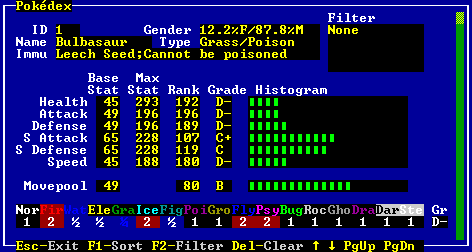 This
Pokédex may give you more information than you are used to seeing about
Pokémon abilities. Some of the more common information shown is the Pokémon
ID, it's Name, Gender Ratios (what percentage of the Pokémon are born
male and which are born female. Some Pokémon, like Staryu
for one, are genderless), Power Type(s), and Immunities.
This
Pokédex may give you more information than you are used to seeing about
Pokémon abilities. Some of the more common information shown is the Pokémon
ID, it's Name, Gender Ratios (what percentage of the Pokémon are born
male and which are born female. Some Pokémon, like Staryu
for one, are genderless), Power Type(s), and Immunities.
Certain natural immunties are conferred by the power type or typess of the Pokémon, described in Table 3.
| Power Type | Immunity |
| Poison |
Can never have the POISON status anomoly
|
| Steel |
Immune to all Poison-type attacks, including ones that
do no damage. May, however, still be poisoned if the attack isn't a Poison-type
attack. The only move that may currently do this is Twinneedle
|
| Fire |
Cannot receive the BURN status anomoly from a Fire-based
move. They may still be burned by a non-Fire move. The only move that
may currently do this is Tri-Attack
|
| Grass |
Leech Seed will always fail
against this power type
|
| Ice |
Immune to FROZEN status anomoly received by Ice attacks.
They may still be frozen by non-Ice moves. The only move that may currently
do this is Tri-Attack
|
| Type | Immunity |
| Dark | Psychic |
| Flying | Ground |
| Ghost | Fighting |
| Ghost | Normal |
| Ground | Electric |
| Normal | Ghost |
| Steel | Poison |
Note: There are seven power types that have complete immunities to another type. If a move's effectiveness is x0 (i.e. immune), then any induced status anomolies will not work (such as Thunder Wave against Ground types or Glare against Ghost types). Confusion, Attraction, and being Cursed are not status anomolies.
Getting more into the numbers aspect are the Base and Max Stats. Also shown is the ranking of each stat category as compared to all other Pokémon. If a Pokémon has a Ranking of 1 in Health, then it has the highest Health of any of the other Pokémon. A ranking of 251 is the bottom of the heap. A Grade of each stat is also shown, which relates directly to its Ranking. The better the Ranking, the better the grade, which follows the scholastic system of A+ through F-. A histogram is also displayed to graphically depict how good a Pokémon is in each ability.
Further down is the ranking of its movepool compared to all other Pokémon. Grade and histogram are also provided.
The bottom of the window shows all the power types and how effective they would be against this Pokémon. You want all these numbers to be as small as possible, obviously. At the far right is the grade of the average effectiveness compared to all other Pokémon. A good grade means not too many moves are effective against it, a poor grade means its vulnerable to many Pokémon attacks.
To move up and down the list incrementally, press the Up and Down arrow. To jump 10 records up or down, press PgUp and PgDn. Pressing Home brings you to the top of the list, End brings you to the bottom.
One powerful tool to help you choose the right Pokémon is using the Sort option (by pressing F1). You can sort the Pokédex by many different criteria, such as:
So if you are looking for a Pokémon high in Health, you can sort the Pokédex by that ability, jump to the top by pressing the Home key, and start searching from there.
The Filter tool is also especially handy to have. A filter may be defined that will limit the Pokédex listings to only Pokémon who can learn one (or more, up to four) moves.
If you have an idea for a Pokémon who can use Ice Beam, simply press F2, select Ice Beam from one of the four moves that you can limit the Pokédex on, then press F1 to apply the filter. Only Pokémon that can use Ice Beam will be displayed.
If you want to remove an existing filter, simply press the Del key from the Pokédex. This will return the Pokédex to showing all Pokémon in whatever Sort order is currently selected.
All the moves in the Pokémon game are available, with complete data and descriptions about each one. This section puts all the move information in one area for easy viewing.
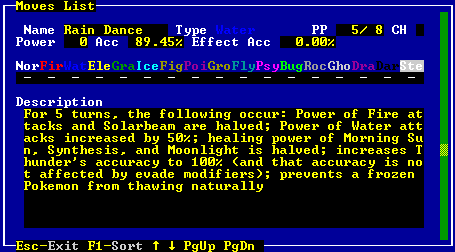 The
list shows the moves Name, Power Type, and PP (showing both game standard and
enhanced by 3 PP UPs, which is commonly accepted in
most tournament play). If a move has a higher-than-normal chance at a critical
hit, there will be a checkmark in the CH box. Also shown is the Power (damage),
move accuracy, and move effect accuracy (yes, they are two different things).
The
list shows the moves Name, Power Type, and PP (showing both game standard and
enhanced by 3 PP UPs, which is commonly accepted in
most tournament play). If a move has a higher-than-normal chance at a critical
hit, there will be a checkmark in the CH box. Also shown is the Power (damage),
move accuracy, and move effect accuracy (yes, they are two different things).
Below these figures is a type effectiveness table showing what single-type Pokémon would be weak against this move. If the move is not an attack-type move, the table simply shows empty dashes.
The moves description is also displayed, which details exactly what this move can do, including move special effects (such as Burn, Confusion, stat adjustment, etc). Some moves are powered up by other moves; other moves provide some very interesting bonuses, penalties, and special immunities.
Just as in the Pokédex, to move up and down the list incrementally, press the Up and Down arrow. To jump 10 records up or down, press PgUp and PgDn. Pressing Home brings you to the top of the list, End brings you to the bottom.
You may sort the Moves List by pressing the F1 key. You will be prompted to choose what to sort the list on. You have many different choices, such as:
All of these choices give you extreme flexibility assisting you choose the right moves for your team.
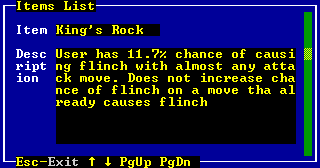 All
the important items can be viewed. Both the name and a description of each item
is provided. Use the Up, Down, PgUp, PgDn,
Home, and End keys to navigate. Press Esc when
you are finished.
All
the important items can be viewed. Both the name and a description of each item
is provided. Use the Up, Down, PgUp, PgDn,
Home, and End keys to navigate. Press Esc when
you are finished.
This is simply a list of the Standards that RMT! uses in its Analysis of your team. This list is by no means all-inclusive. Many of you experienced users might argue that there is at least one Standard for every single Pokémon. While this may be true, it would only serve as a detriment to include hundreds of Standards. The user would have no idea what to do deluged with this much information during the team Analysis. This is simply a short list of the most common of Standards that will give the user a quick idea how his team would stand up.
What good is a program that can't let you save your work? This option, in conjunction with the Save Team File option, allows storage of your team.
The storage-device's directory (hard drive, floppy drive, CD-RW, etc.) is shown at the top of the window. All files in the directory are shown below, along with the current-directory (single red dot) and the "up-one-level" parent-directory (red double-dots). Use the arrow keys to navigate the highlighted cursor to the team filename you want to load and press Enter. You may also simply type in the name of a file you wish to load.
Note: Since this is a DOS application, long filenames are not supported.
If you attempt to load a file that is not a RMT! team file or the file is not the correct revision, you will receive an error.
Use the arrow keys to navigate the directory until you find the file you want to overwrite, or simply start typing the filename you want to use to save your team. The filename will be displayed at the bottom of the window.
Note: You will not be prompted before overwriting an existing file.
There are times when you may want a hard-copy of your team, either for further study while not in front of a computer, or to show friends. The following report will be printed:
Printing will go through the PRN device in DOS/Windows, which means it will be handled by the operating system and sent to the Print Manager to your printer like any other print job.
Select this option to view the built-in instruction document. Use the Up, Down, PgUp, PgDn, Home, and End keys to navigate the instructions.
Self-explanatory. Any data or team that hasn't been saved to a file will be lost upon exit of the program.
There are certain commands that may be executed when the program first loads. These commands are accessed by using specific command-line parameters. These are:
You have to modify the shortcut (.PIF) file to include command-line parameters. Right-click the shortcut on the desktop and click Properties. Click the Program tab and include the desired command-line parameters inside the command listed in the Cmd line: field.
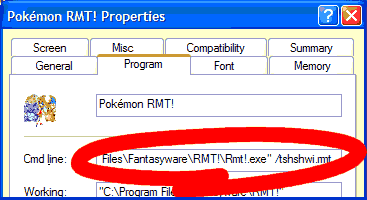
Example: "C:\Program Files\Fantasyware\RMT!\RMT!.exe" /tmyteam.rmt
(Users of Windows 3.1 will have to run the PIF Editor applet in their Control Panel.)
You can create a batchfile (.BAT) to automatically start with certain options. It saves having to always change it when you start. Open a new textfile with EDIT or other text editor. Enter "RMT!" followed by all the desired command-line options. Save the file with a .BAT file extension.
Example: "RMT! /tmyteam.rmt"
I've spent a long time deciding exactly which Pokémon I want on my team. RMT! wants me to change that by making suggestions of other Pokémon. Do I really have to change my team?
Absolutely not. You don't have to do anything you don't want to do. Keep in mind that, while RMT! excels in some areas, it is fallible and might not see a complicated battle strategy you have devised. If you believe this to be the case, simply ignore the suggestion.
RMT! makes some suggestions that I don't know what to do about, such as saying a particular Pokémon's stat is low. That's kind of out of my control, what does it expect me to do?
Obviously, there are many things you can't change about the game, but there are some things you can control. If the program has several criticisms about your choice of Pokémon, perhaps you need to re-think your lineup. That is what RMT! is suggesting to you by bringing up things like that—don't try to fit a square peg in a round hole. If a team member has too many fundamental problems, you might want to make a change.
After putting my team through RMT! and making the suggested changes, my team is still getting whomped on in the arena. What am I doing wrong?
There could be several reasons why you have been unsuccessful. Carefully analyze the moves you have available on your team. Are you utilizing them effectively? Are there any moves on your team that you aren't using at all—if so, why? Also, ask other carbon-based team raters (others players). A good rater can blow RMT! out of the water, just as a chess champion can beat the pants off most chess programs. Observe other players—what are they doing that you aren't?
Possibly the most valuable advice of all: Learn from experience. If you get swept by a Curselax, try adding some sort of counter to your team (such as a Hazer or Psych-Upper), or try and keep it from happening next time by learning to use the power of intuition in order to see what's coming.
Hey, I want to use my favorite Pokémon who uses Psych Up. Where is the role for Psych Upper?
I'm sure you realize that there are an infinite number of roles that could be created revolving around one or more moves on a Pokémon. A role simply helps you to focus on what it's job will be. Try to use the roles available in the program and if you don't see one that fits, just select <none>.
It's too hard to read the small text in the RMT! window. Also, other applications running in other windows slow down too much.
There are many features you can configure in RMT!'s shortcut. Right-click the Pokémon RMT! shortcut on your Desktop and select Properties. You will see several tabbed options. To increase the text size in the Window, select the Font tab and choose a font size more to your liking. To speed up other programs that may be running, click the Misc tab and adjust the Idle Sensitivity to a low setting.
Many different terms have been created and have evolved in the world of Pokémon. Some terminology has migrated from other video games, others are specific to this game. Here is a list of common terms used both in this FAQ and by RMT!
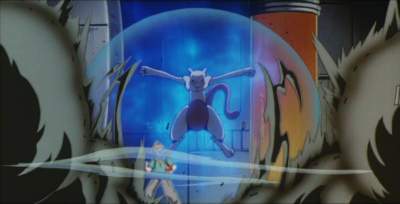 Übers
ÜbersUnfortunately, no program is perfect, and neither is Pokémon RMT! Here is a list of known problems with the program that will be fixed in the next version.
I have been very lucky to have some absolutely great beta testers for RMT! Without them—their insights, suggestions, and most definitely criticisms—this program would not exist.
In my research far and wide for anything I could add to RMT! to make it useful, I came across some truly wonderful sites.
I hope you found this program useful, easy to use, and fun. If you have any suggestions, opinions, or questions, feel free to contact me.
All trademarks for Pokémon ©1995-2002 Nintendo/Creatures Inc/Game Freak, Inc.